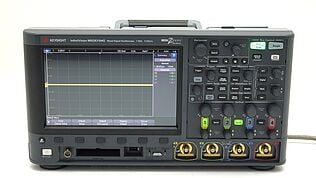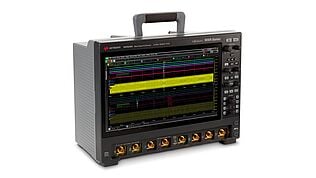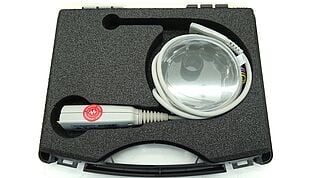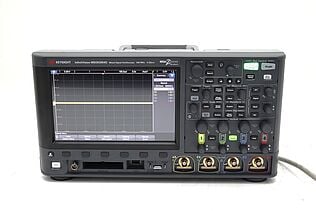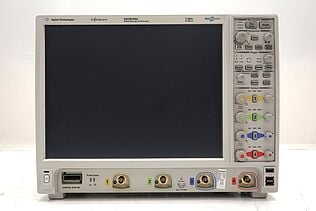- Introduction
- Understanding Bandwidth in Oscilloscopes
- The 3dB Point and Its Relationship with Sampling Rate
- Importance of Bandwidth in Oscilloscopes
- Accurate Measurements
- Signal Integrity
- Versatility Across Applications
- Types of Bandwidth Limitations in Oscilloscopes
- Hardware Limitations
- Software Limitations
- Selecting the Right Bandwidth for Your Oscilloscope
- Bandwidth Limit Settings
- Real-world Applications and Bandwidth Requirements
- High-Speed Digital Signals
- RF Applications
- Power Supply Design
- Conclusion
- Whenever You’re Ready, Here Are 5 Ways We Can Help You
Imagine trying to capture the intricate details of a painting with a low-resolution camera; you'd miss the subtleties that give the art its value. Similarly, when it comes to oscilloscopes, bandwidth acts like the "resolution" of your measurements.
A higher bandwidth allows you to capture and analyze more complex, high-frequency signals with greater accuracy, much like how a high-resolution camera captures finer details.
In this comprehensive guide, we'll explore the critical role of bandwidth in oscilloscopes, why it's crucial to your work, and how to make the best choice for your specific needs.
| Key Takeaway |
|---|
| Choosing the right bandwidth for your oscilloscope is crucial for accurate and reliable measurements across a variety of engineering applications. Ignoring bandwidth limitations can result in compromised data quality, misleading results, and decreased versatility in tackling different tasks. |
Explore Keysight’s Range of Oscilloscopes Today
Understanding Bandwidth in Oscilloscopes
Bandwidth defines the range of frequencies that an oscilloscope can accurately measure. Bandwidth is measured in Hertz (Hz), often in megahertz (MHz) or gigahertz (GHz).
The 3dB Point and Its Relationship with Sampling Rate
Understanding the 3dB point is crucial for effective oscilloscope usage. This is the frequency where the amplitude of your displayed signal falls to about 70.7% of its maximum value. The significance of the 3dB point is twofold:
- High vs low: A higher 3dB point equates to a wider bandwidth, enabling more accurate high-frequency measurements. A lower one, conversely, limits you to lower frequencies.
- Sampling rate: The Nyquist Criterion states that the sampling rate should be at least twice the highest frequency component you're measuring. However, as a rule of thumb, aim for a sampling rate five times the bandwidth for greater accuracy.
By grasping these two elements, you not only optimize your oscilloscope's performance but also ensure reliable and accurate data collection.
Importance of Bandwidth in Oscilloscopes
When working with oscilloscopes, ignoring bandwidth is not an option. Here's a deep dive into why bandwidth holds pivotal importance in the world of signal measurement and analysis.
Accurate Measurements
The foremost reason for considering bandwidth is its direct impact on the accuracy of your measurements, especially for high-frequency components.
Let's say you're dealing with digital signals that have fast rise times or analog signals that carry high-frequency information. An oscilloscope with inadequate bandwidth will not capture these aspects accurately, causing critical errors in your data.
Essentially, the higher the bandwidth, the more faithful the oscilloscope is to the original signal, reducing distortions and providing a true representation.
Signal Integrity
Low bandwidth doesn't merely compromise accuracy; it also risks the integrity of your signal measurements. An oscilloscope with limited bandwidth may introduce errors and artifacts, such as aliasing or amplitude inaccuracies.
In real-world applications, these errors can be more than just an annoyance; they can lead to incorrect conclusions, wasted time, and even failed projects. Therefore, maintaining the integrity of your signal is crucial, and that's where sufficient bandwidth comes in.
Versatility Across Applications
Beyond accuracy and integrity, bandwidth also impacts the versatility of the oscilloscope. Engineering projects often involve a multitude of signals and applications—from analyzing high-speed data lines to measuring noisy analog signals.
A higher bandwidth oscilloscope acts like a Swiss Army knife, allowing you to tackle a broader range of applications without switching equipment.
This adaptability not only makes your work more efficient but also future-proofs your investment, as you can use the same oscilloscope for different tasks or evolving project requirements.
Types of Bandwidth Limitations in Oscilloscopes
Understanding the different types of bandwidth limitations can help you make informed decisions when choosing an oscilloscope or diagnosing performance issues.
These limitations can arise from both hardware and software aspects of the oscilloscope, each impacting your measurements in different ways.
Hardware Limitations
Analog Bandwidth
The analog bandwidth is inherently determined by the oscilloscope's analog front-end circuitry. This includes components like amplifiers, resistors, and capacitors that shape and condition the incoming signal.
A sub-optimal or aged front-end can reduce the analog bandwidth, thereby limiting the range of frequencies the oscilloscope can effectively measure. The analog bandwidth is often the first specification engineers look at, but it's just one part of the puzzle.
Digital Bandwidth
Digital bandwidth, on the other hand, is dictated by the analog-to-digital converter (ADC) and subsequent signal processing capabilities.
The ADC samples the conditioned analog signal and transforms it into a digital form for display and analysis. The speed and resolution of the ADC play a critical role in how high a frequency your oscilloscope can capture and display accurately.
For instance, an 8-bit ADC offers less resolution than a 12-bit ADC, affecting the digital bandwidth and ultimately, the quality of your measurements.
Software Limitations
Filtering Capabilities
Beyond hardware, software also imposes limitations on bandwidth through features like digital filtering. Software filters can be beneficial for isolating specific frequency components in your signal but can also artificially limit the bandwidth.
For example, using a low-pass filter may eliminate unwanted high-frequency noise but can also discard valid high-frequency components if not set correctly. While software-imposed limitations can often be adjusted, they still pose a restriction that users need to be aware of.
Understanding the nuances of hardware and software-induced bandwidth limitations provides you with the knowledge to select an oscilloscope wisely and use it effectively.
Whether it's the components in the analog front-end, the capabilities of the ADC, or the flexibility of software settings, each plays a role in determining how your oscilloscope performs and should influence your choice and usage strategy.
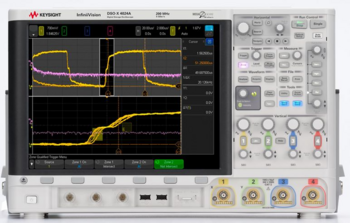
Selecting the Right Bandwidth for Your Oscilloscope
Choosing the correct bandwidth for your oscilloscope isn't just a matter of grabbing the one with the highest specs. It involves careful consideration of your specific requirements and the tasks you'll be performing.
Here are 3 key factors you should consider.
Consider the Highest Frequency Component
The first step is to identify the highest frequency component within your signal. Whether you are working on a digital or analog project, knowing this frequency will set the stage for all other decisions.
You can either calculate this based on the characteristics of the signal you're working with or refer to specifications if dealing with a known standard.
- Tip: Use a spectrum analyzer or specialized software if you're uncertain about how to identify the highest frequency components.
Apply the 5x Rule for Safety
Once you've established the highest frequency component in your signal, apply the 5x rule. This means you should select an oscilloscope with a bandwidth at least five times higher than this frequency.
This extra bandwidth provides a safety margin, ensuring you can capture higher harmonic frequencies and transient events that could otherwise be missed.
- Why 5x?: This ratio not only satisfies the Nyquist Criterion but also provides room for capturing unforeseen high-frequency components.
Look for Bandwidth Upgradeability
Technology evolves, and so do project requirements. Some of the modern oscilloscopes offer bandwidth upgradeability, a feature that allows you to extend the scope's bandwidth capabilities as needs change.
This offers the flexibility to adapt to new challenges without needing to purchase a completely new oscilloscope.
- Future-proofing: An upgradeable bandwidth ensures your oscilloscope can adapt to future project requirements, providing a longer life span for your investment.
By paying close attention to these key factors, you'll be in a much better position to select an oscilloscope that not only meets your current needs but also offers a degree of future-proofing.
This focused approach will lead to more accurate and reliable measurements, ultimately contributing to the success of your engineering projects.
Bandwidth Limit Settings
| Setting | Description | Application |
| Full | No limit set, uses the maximum hardware bandwidth. | General-purpose, versatile applications. |
| User-defined | Specific limit set by the user. | Specialized measurements, noise reduction. |
| Auto | Oscilloscope dynamically adjusts bandwidth. | Adaptive measurement conditions. |
Real-world Applications and Bandwidth Requirements
Understanding the specific needs of various real-world applications can illuminate why bandwidth is such a crucial specification for oscilloscopes.
From high-speed digital systems to RF applications and power supply design, each use-case has its unique bandwidth requirements for optimal performance.
High-Speed Digital Signals
In the realm of high-speed digital signals—such as those in USB 3.0, HDMI, and Ethernet applications—the importance of having a high bandwidth oscilloscope cannot be overstated.
For tasks like measuring edge transitions, characterizing eye diagrams, or validating signal integrity, high bandwidth is essential. With higher bandwidth, you can capture more details of rapid transitions, thereby enabling more accurate time-domain and frequency-domain measurements.
- Why it matters: High bandwidth ensures accurate edge-transition measurements, which are critical for debugging and characterizing high-speed digital interfaces.
RF Applications
When dealing with radio frequency (RF) applications, bandwidth becomes pivotal in capturing and analyzing modulated signals.
Whether you are working on Wi-Fi, Bluetooth, or any other RF communication system, you need sufficient bandwidth to measure the envelope and sidebands of modulated signals accurately.
Insufficient bandwidth can lead to misleading results and hamper your ability to diagnose issues or optimize performance.
- Significance: Bandwidth directly impacts your ability to characterize and troubleshoot modulated signals in RF systems.
Power Supply Design
Contrary to high-speed and RF applications, power supply design tasks like measuring ripple, noise, and transient responses may not demand high bandwidth. In many cases, a low-to-moderate bandwidth oscilloscope can suffice.
However, it's essential to ensure that the oscilloscope's bandwidth is still adequate for the frequencies involved, especially when you are concerned with high-frequency switching noise or transients.
- Low Bandwidth Can Suffice: Lower bandwidth is generally acceptable for measuring slower phenomena like ripple and noise in power supplies, but always confirm it meets your specific requirements.
Discover Our Selection of Used Oscilloscopes
Select up to 3 instruments to compare
Enable Notifications
In order to use this feature, you need to enable notifications.
Manage notification preferences
Conclusion
The bandwidth of an oscilloscope is more than just a number on a technical sheet—it's a crucial factor that impacts the accuracy, reliability, and versatility of your measurements.
From determining the highest frequency components in your signals to future-proofing your equipment, understanding bandwidth limitations and requirements can make or break the success of your engineering projects.
Selecting the right bandwidth is not merely an academic exercise; it's a practical necessity that resonates across a wide range of real-world applications.
If you're looking to invest in an oscilloscope that meets your specific bandwidth requirements, or perhaps you need other types of measurement equipment like signal analyzers, function generators, and multimeters, consider visiting the Keysight Used Equipment Store.
Here, you'll find premium used equipment that offers top-of-the-line performance at budget-friendly prices. Don't compromise on quality when you can get the best of both worlds—accuracy and affordability.

Whenever You’re Ready, Here Are 5 Ways We Can Help You
- Browse our Premium Used Oscilloscopes.
- Call tech support US: +1 800 829-4444
Press #, then 2. Hours: 7 am – 5 pm MT, Mon– Fri - Talk to our sales support team by clicking the icon (bottom right corner) on every offer page
- Create an account to get price alerts and access to exclusive waitlists.
- Talk to your account manager about your specific needs.



